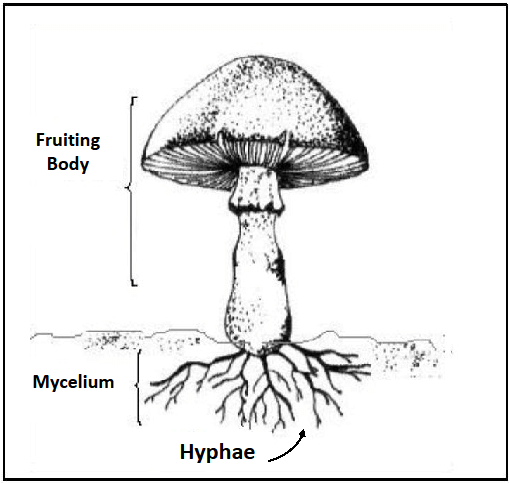One of the basic properties of the mycelium is that it is a network which is composed of myriads of very fine filaments called hypha. This leads to a primal image of the Church as being an aggregate of individuals and not an isolated individual as represented by the singular human form. Many properties of the mycelium are due to the nature of the hyphae which compose it. Hyphae are cylindrical tubes of a microscopic diameter, 5 microns. They are filled with protoplasm (or in more modern terms, cytoplasm), a fluid that extends throughout their length.
The hyphae grow by extension alone and do not increase their diameters. A strong wall coats them to offer protection from being clamped shut by external forces. One might suggest that they are armored in that regard. Immediately inside this wall is a semipermeable membrane that allows for certain compounds to enter while rejecting others from the surrounding environment. As the hyphae lengthen, depending on a number of factors, some of them have the option of fusing with adjacent hyphae based on a significant number of mating factors (and not just two as for humans). It is this fusing that leads to the mycelium becoming a network. The mycelial network is self-organized requiring no external controls. While the primary focus of growth is linear, hyphae have the capacity to branch. It is branching that emulates cell division. Branching depends usually on the external condition of availability of resources needed for survival. In case of a plenitude of nutrients branching will be extensive creating a mat-like
confluence of hyphae to that region. In the opposite case of a dearth of nutrients the hyphae tend
to continue growth away from the more populated regions.
Thus, there are two primary forms of extension of a mycelium: exploitative and exploratory or in theological terms, congregational connectedness and missional outreach. Because the mycelium is a living network in which all its hyphal parts are connected and communicating via the protoplasm, it is globally aware of all local conditions that affect it. And as a result of changing local conditions it may need to reorganize due to depletion of old resources or acquisition of new plentiful ones. Thus the mycelium is in all stages of growth simultaneously and constantly undergoing change to meet local changing environmental conditions. In this manner it fulfills the Protestant principle of Ecclesia reformata, semper reformanda (The Church reformed, always being [to be] reformed.) Let it be emphasized, the mycelium has a morphology for change.
Hyphae require oxygen to survive like all animals, not carbon dioxide like plants. Hyphae have a unique way of acquiring nutrition. Unlike animals which first engulf their food and then digest it or plants which manufacture their food directly from minerals assisted by sunlight, hyphae excrete their digestive enzymes into the surrounding environment where they digest the nutrients that are to be found. Then these products are absorbed back through the hyphal walls. This difference helped biologists realize that fungi were not plants and belonged in a different kingdom than either plants or animals.
This knowledge can help establish that the Church is more than a human organization even though constituted by humans. Further, because the nutrients are made available in the environment, any organism nearby can also ingest them for their own nourishment. And whatever else is not absorbed sinks into the soil making it much more fertile. Thus, the method of feeding by hyphae creates environmental abundance rather than scarcity; the opposite that animals create when they remove items from the environment for private use. Further, the scattered, heterogeneous distribution of nutrients in the soil demands that the mycelium not follow any specified pattern for its growth and development but turns irregularly through the soil seeking the hidden nutrients.
This means that unlike animals which have specific forms when reaching maturity, the mycelium necessarily has an indeterminate form that is exceedingly entangled in which its hyphae all approach having shapes that are known in mathematics as fractal form.

